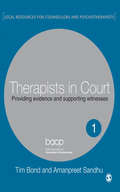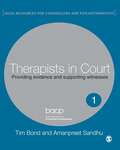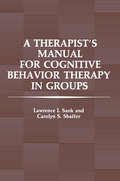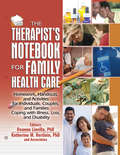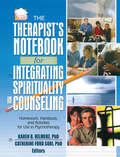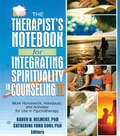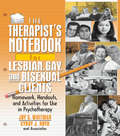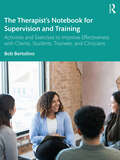- Table View
- List View
A Therapist’s Guide to Writing in Psychotherapy: Assessment, Documentation, and Intervention
by Michael D. ReiterThis guide practically aids mental health professionals in understanding and improving their therapeutic and academic writing, demonstrating how the written word is an invaluable tool to document, assess, and promote change with those in and outside the therapy room. Exploring the various ways writing occurs in psychotherapy professions, Michael D. Reiter comprehensively covers the range of the written word, from progress notes and assessment documentation, to journaling and therapeutic letters, as well as contacting larger systems such as report writing and grant applications. Chapters are formatted to include the purpose and function of a particular type of writing before providing multiple examples so therapists can apply this in their own practice. This book aims to help all therapists, regardless of academic training or therapeutic modality, to incorporate these ideas into their work. This book is designed for mental health professionals in a variety of settings, including counselors, therapists, social workers, family therapists, and clinical psychologists. This book is useful for graduate students as well as those already in practice.
A Therapist’s Handbook to Dissolve Shame and Defense: Master the Moment
by Susan Warren WarshowThe effort to surmount shame and formidable defenses in psychotherapy can trigger shame and self-doubt in therapists. Susan Warren Warshow offers a user-friendly-guide to help therapists move past common treatment barriers. This unique book avoids jargon and breaks down complex concepts into digestible elements for practical application. The core principles of Dynamic Emotional Focused Therapy (DEFT), a comprehensive treatment approach for demonstrable change, are illustrated with rich and abundant clinical vignettes. This engaging, often lyrical handbook emphasizes "shame-sensitivity" to create the safety necessary to achieve profound interpersonal connection. Often overlooked in treatment, shame can undermine the entire process. The author explains the "therapeutic transfer of compassion for self," a relational phenomenon that purposefully generates affective expression. She introduces a three-step, robust framework, The Healing Triad, to orient therapists to intervene effectively when the winds of resistance arise. Chapters clarify: Why we focus on feelings How to identify and move beyond shame and anxiety How to transform toxic guilt into reparative actions How to disarm defenses while avoiding ruptures This book is essential reading for both advanced and newly practicing mental health practitioners striving to access the profound emotions in their clients for transformative change.
A Therapist’s Handbook to Dissolve Shame and Defense: Master the Moment
by Susan Warren WarshowThe effort to surmount shame and formidable defenses in psychotherapy can trigger shame and self-doubt in therapists. Susan Warren Warshow offers a user-friendly-guide to help therapists move past common treatment barriers. This unique book avoids jargon and breaks down complex concepts into digestible elements for practical application. The core principles of Dynamic Emotional Focused Therapy (DEFT), a comprehensive treatment approach for demonstrable change, are illustrated with rich and abundant clinical vignettes. This engaging, often lyrical handbook emphasizes "shame-sensitivity" to create the safety necessary to achieve profound interpersonal connection. Often overlooked in treatment, shame can undermine the entire process. The author explains the "therapeutic transfer of compassion for self," a relational phenomenon that purposefully generates affective expression. She introduces a three-step, robust framework, The Healing Triad, to orient therapists to intervene effectively when the winds of resistance arise. Chapters clarify: Why we focus on feelings How to identify and move beyond shame and anxiety How to transform toxic guilt into reparative actions How to disarm defenses while avoiding ruptures This book is essential reading for both advanced and newly practicing mental health practitioners striving to access the profound emotions in their clients for transformative change.
Therapists in Court: Providing Evidence and Supporting Witnesses
by Amanpreet Sandhu Tim Bond`A recent SAGE Publication called Therapists in Court provides invaluable, step-by-step guidance to mental health practitioners in the UK. Even though different countries use different legal systems, many issues faced in the legal domain are based on the principle of protecting the rights of both parties and balancing often competing roles. Despite its base in the UK legal system, Therpists in Court provides essential advice on many of these issues for all mental health practitioners, regardless of their location' - New Therapist `[Therapists in Court] spells out very clearly the vastly different worlds of therapy and the courts. Detailed and careful preparation is advised although not offered by the courts to the uninitiated. There are many examples given of typical Initial Statements; Disclosure Documents; and several different Court Reports which may be requested under different circumstances. This is a user-friendly handbook that one can use to get an initial overview of the likely legal scenarios therapists may experience, and which can be used for more detailed study if and when the need arises. Tim Bond and Amanpreet Sandhu provide therapists with a useful reference in which the legal process as it may apply to themselves and/or their clients becomes more easily understood' - Eisteach 'This book fills an important gap in the literature and will I hope remain in print long term, with appropriate amendments and revisions. It should be read by any therapist whose client is or may be involved in court proceedings, civil or criminal, as witness, plaintiff or defendant: that is, by all therapists of any discipline. It will be essential reading for trainees. I wish it had been around when I was learning my job' - Dr Jean Harris - Hendriks, Honorary Senior Lecturer and Consultant in Child and Adolescent Psychiatry, Traumatic Stress Clinic, London `Therapists in Court provides a clear and useful summary of what to do when faced with legal processes and will be extremely helpful both to counsellors called to provide evidence in court and to lawyers who wish to refer their clients for support during the legal process or afterwards´ - Sarah J Head, Client Support Manager, Alexander Harris Solicitors `It is extraordinary that no such work already exists. I predict that Therapists in Court will become not just useful but indispensable to all practitioners, not least because of the accessible and jargon-free language in which the law is conveyed. Ultimately, clients will be the beneficiaries of a better informed profession´ - Marcel Berlins, Barrister, Author of The Law Machine, Media Law Module Leader at City University London, and Guardian Legal Correspondant 'It often happens that lawyers get frustrated trying to find the answer to a point of law in their textbooks. Therapist need have no such worries! When trying to find out how the courts of law may affect them in their work, they will find it all here - in a comprehensive and very readable account of what is involved. Here is all you ever wanted to know about the courts but were afraid to ask!' - Sheriff Nigel Thomas CBE `So many therapy books contain too much padding with references to other published work that is already familiar. The reader has to work hard to 'extract the gold from the dross'. This title is not one of these. Your review read the whole book through in one sitting because of the clarity of the writing and logical sequence. I wanted to know what to do next. Bearing in mind that this is about legal matters, it may be described as 'un-putdownable' - Play for Life Therapists in Court is the first in a series of handbooks providing legal guidance for practitioners from all the talking therapies, including counselling, psychotherapy and psychology. For many practitioners, becoming involved in a court case is a frightening and disturbing experience. The tone of legal letters and the adversarial atmosphere of a courtroom is very different from their usual working environment. Providing clear practical guidance backed up with illuminating examples, th...
Therapists in Court: Providing Evidence and Supporting Witnesses
by Amanpreet Sandhu Tim Bond`A recent SAGE Publication called Therapists in Court provides invaluable, step-by-step guidance to mental health practitioners in the UK. Even though different countries use different legal systems, many issues faced in the legal domain are based on the principle of protecting the rights of both parties and balancing often competing roles. Despite its base in the UK legal system, Therpists in Court provides essential advice on many of these issues for all mental health practitioners, regardless of their location' - New Therapist `[Therapists in Court] spells out very clearly the vastly different worlds of therapy and the courts. Detailed and careful preparation is advised although not offered by the courts to the uninitiated. There are many examples given of typical Initial Statements; Disclosure Documents; and several different Court Reports which may be requested under different circumstances. This is a user-friendly handbook that one can use to get an initial overview of the likely legal scenarios therapists may experience, and which can be used for more detailed study if and when the need arises. Tim Bond and Amanpreet Sandhu provide therapists with a useful reference in which the legal process as it may apply to themselves and/or their clients becomes more easily understood' - Eisteach 'This book fills an important gap in the literature and will I hope remain in print long term, with appropriate amendments and revisions. It should be read by any therapist whose client is or may be involved in court proceedings, civil or criminal, as witness, plaintiff or defendant: that is, by all therapists of any discipline. It will be essential reading for trainees. I wish it had been around when I was learning my job' - Dr Jean Harris - Hendriks, Honorary Senior Lecturer and Consultant in Child and Adolescent Psychiatry, Traumatic Stress Clinic, London `Therapists in Court provides a clear and useful summary of what to do when faced with legal processes and will be extremely helpful both to counsellors called to provide evidence in court and to lawyers who wish to refer their clients for support during the legal process or afterwards´ - Sarah J Head, Client Support Manager, Alexander Harris Solicitors `It is extraordinary that no such work already exists. I predict that Therapists in Court will become not just useful but indispensable to all practitioners, not least because of the accessible and jargon-free language in which the law is conveyed. Ultimately, clients will be the beneficiaries of a better informed profession´ - Marcel Berlins, Barrister, Author of The Law Machine, Media Law Module Leader at City University London, and Guardian Legal Correspondant 'It often happens that lawyers get frustrated trying to find the answer to a point of law in their textbooks. Therapist need have no such worries! When trying to find out how the courts of law may affect them in their work, they will find it all here - in a comprehensive and very readable account of what is involved. Here is all you ever wanted to know about the courts but were afraid to ask!' - Sheriff Nigel Thomas CBE `So many therapy books contain too much padding with references to other published work that is already familiar. The reader has to work hard to 'extract the gold from the dross'. This title is not one of these. Your review read the whole book through in one sitting because of the clarity of the writing and logical sequence. I wanted to know what to do next. Bearing in mind that this is about legal matters, it may be described as 'un-putdownable' - Play for Life Therapists in Court is the first in a series of handbooks providing legal guidance for practitioners from all the talking therapies, including counselling, psychotherapy and psychology. For many practitioners, becoming involved in a court case is a frightening and disturbing experience. The tone of legal letters and the adversarial atmosphere of a courtroom is very different from their usual working environment. Providing clear practical guidance backed up with illuminating examples, th...
Therapists, Lawyers, and Divorcing Spouses
by William FisherExperts explore the need for cooperation between the law and helping professions in order to lessen the trauma of the divorce process.
Therapists, Lawyers, and Divorcing Spouses
by William FisherExperts explore the need for cooperation between the law and helping professions in order to lessen the trauma of the divorce process.
A Therapist’s Manual for Cognitive Behavior Therapy in Groups
by L.I. Sank C.S. ShafferOne of the great advantages of rational-emotive therapy (RET) and cog nitive behavior therapy (CBT) is that they frequently employ psycho educational methods-including bibliotherapy, workshops, lectures, courses, recordings, and films. I created RET at the beginning of 1955 after I had abandoned the practice of psychoanalysis because I found it to be highly inefficient and philosophically superficial. Being almost addicted to one-to-one therapy as a result of my analytic training and experience, I at first did RET only with individual clients and found this pioneering form of CBT considerably more effective than the other ther apies with which I had experimented. By 1957, however, I realized that RET could be taught to large num bers of persons through self-help books and articles and that RET -ori ented writings could not only prove valuable to the general public but that they could also be successfully employed to hasten and intensify the therapy of my individual clients. I therefore wrote a number of RET self help books-especially How to Live with a Neurotic (1957), Sex without Guilt (1958), A New Guide to Rational Living (with Robert A. Harper; original edition, 1961), and A Guide to Successful Marriage (with Robert A. Harper, 1961).
The Therapist's Notebook for Families: Solution-Oriented Exercises for Working With Parents, Children, and Adolescents
by Bob BertolinoThe Therapist’s Notebook for Families, Second Edition, provides 72 solution-oriented activities for an array of challenging problems faced by mental health professionals when working with clients. The Therapist's Notebook offers clear, practical, easy-to-use exercises to help therapists work effectively and creatively with parents, adolescents, children, and families. Its solution-focused perspective provides a foundation based on collaboration, the utilization of client strengths, and the creation of possibilities to facilitate present and future change. The book is arranged in five parts, with 15 fully revised and 23 brand-new exercises.
The Therapist's Notebook for Families: Solution-Oriented Exercises for Working With Parents, Children, and Adolescents
by Bob BertolinoThe Therapist’s Notebook for Families, Second Edition, provides 72 solution-oriented activities for an array of challenging problems faced by mental health professionals when working with clients. The Therapist's Notebook offers clear, practical, easy-to-use exercises to help therapists work effectively and creatively with parents, adolescents, children, and families. Its solution-focused perspective provides a foundation based on collaboration, the utilization of client strengths, and the creation of possibilities to facilitate present and future change. The book is arranged in five parts, with 15 fully revised and 23 brand-new exercises.
The Therapist's Notebook for Family Health Care: Homework, Handouts, and Activities for Individuals, Couples, and Families Coping with Illness, Loss, and Disability
by Deanna Linville Katherine M. HertleinEffective interventions to help your clients deal with illness, disability, grief, and loss The Therapist’s Notebook for Family Health Care presents creative interventions for working with individuals, couples, and families dealing with illness, loss, and disability. This book offers creative resources like homework, handouts, and activities, and effective, field-tested interventions to provide counselors with useful information on specific family dynamics and topics. It equips mental health clinicians with practical therapeutic activities to use in their work with clients struggling with health care or grief issues. The effects of illness, disability, and loss in everyday life can be profound. Besides the individual repercussions, these challenges also affect the lives of the family and social networks of those individuals experiencing them. The Therapist’s Notebook for Family Health Care brings together the knowledge and experience of over 30 experts in the field for a unique collection that therapists and clients alike will find immediately useful. Situated in four unique subject-specific sections for quick reference, this text covers a broad scope of common problems. Also included is a bonus section focusing on thoughtful suggestions for self-care and professional development. Some of the many topics and techniques presented in The Therapist’s Notebook for Family Health Care include: conducting interviews using the biopsychosocial-spiritual method using the Family System Test (FAST) to explore clients’ experiences with their healthcare system and providers increasing social support to manage chronic illness coping and adapting to developmental changes, challenges, and opportunities using a patient education tool in family therapy helping children (and their families) to manage pain through knowledge and diaphragmatic breathing creating a personal “superhero” for a child as a means to empowerment and relief of anxiety facilitating family problems using scatterplots building functional perspective of self and others in clients with Asperger Syndrome quilting as a meaning-making intervention for HIV/AIDS empowering terminally-ill patients to say goodbye to their young children in meaningful ways and many more!With a wealth of tables, charts, handouts, and bibliotherapy resources for clients; readings and resources for clinicians; and case vignettes, The Therapist’s Notebook for Family Health Care is an excellent resource for a wide variety of practitioners, including, counselors, psychologists, social workers, grief workers, hospice workers, health psychologists, and medical social workers. It is also an ideal text for psychotherapy and counseling students and educators.
The Therapist's Notebook for Family Health Care: Homework, Handouts, and Activities for Individuals, Couples, and Families Coping with Illness, Loss, and Disability
by Deanna Linville Katherine M. HertleinEffective interventions to help your clients deal with illness, disability, grief, and loss The Therapist’s Notebook for Family Health Care presents creative interventions for working with individuals, couples, and families dealing with illness, loss, and disability. This book offers creative resources like homework, handouts, and activities, and effective, field-tested interventions to provide counselors with useful information on specific family dynamics and topics. It equips mental health clinicians with practical therapeutic activities to use in their work with clients struggling with health care or grief issues. The effects of illness, disability, and loss in everyday life can be profound. Besides the individual repercussions, these challenges also affect the lives of the family and social networks of those individuals experiencing them. The Therapist’s Notebook for Family Health Care brings together the knowledge and experience of over 30 experts in the field for a unique collection that therapists and clients alike will find immediately useful. Situated in four unique subject-specific sections for quick reference, this text covers a broad scope of common problems. Also included is a bonus section focusing on thoughtful suggestions for self-care and professional development. Some of the many topics and techniques presented in The Therapist’s Notebook for Family Health Care include: conducting interviews using the biopsychosocial-spiritual method using the Family System Test (FAST) to explore clients’ experiences with their healthcare system and providers increasing social support to manage chronic illness coping and adapting to developmental changes, challenges, and opportunities using a patient education tool in family therapy helping children (and their families) to manage pain through knowledge and diaphragmatic breathing creating a personal “superhero” for a child as a means to empowerment and relief of anxiety facilitating family problems using scatterplots building functional perspective of self and others in clients with Asperger Syndrome quilting as a meaning-making intervention for HIV/AIDS empowering terminally-ill patients to say goodbye to their young children in meaningful ways and many more!With a wealth of tables, charts, handouts, and bibliotherapy resources for clients; readings and resources for clinicians; and case vignettes, The Therapist’s Notebook for Family Health Care is an excellent resource for a wide variety of practitioners, including, counselors, psychologists, social workers, grief workers, hospice workers, health psychologists, and medical social workers. It is also an ideal text for psychotherapy and counseling students and educators.
The Therapist's Notebook for Integrating Spirituality in Counseling I: Homework, Handouts, and Activities for Use in Psychotherapy
by Karen B. Helmeke Catherine Ford SoriLearn to initiate the integration of your clients’ spirituality as an effective practical intervention. A client’s spiritual and religious beliefs can be an effective springboard for productive therapy. How can a therapist sensitively prepare for the task? The Therapist’s Notebook for Integrating Spirituality in Counseling is the first volume of a comprehensive two-volume resource that provides practical interventions from a wide range of backgrounds and theoretical perspectives. This volume helps prepare clinicians to undertake and initiate the integration of spirituality in therapy with clients and provides easy-to-follow examples. The book provides a helpful starting point to address a broad range of topics and problems. The chapters of The Therapist’s Notebook for Integrating Spirituality in Counseling are grouped into five sections: Therapist Preparation and Professional Development; Assessment of Spirituality; Integrating Spirituality in Couples Therapy; Specific Techniques and/or Topics Used in Integrating Spirituality; and Use of Scripture, Prayer, and Other Spiritual Practices. Designed to be clinician-friendly, each chapter also includes sections on resources where counselors can learn more about the topic or technique used in the chapter—as well as suggested books, articles, chapters, videos, and Web sites to recommend to clients. Each chapter utilizes similar formatting to remain clear and easy-to-follow that includes objectives, rationale for use, instructions, brief vignette, suggestions for follow-up, contraindications, references, professional readings and resources, and bibliotherapy sources for the client. The first volume of The Therapist’s Notebook for Integrating Spirituality in Counseling helps set a solid foundation and provides comprehensive instruction on: ethically incorporating spirituality into the therapeutic setting professional disclosure building a spiritual referral source through local clergy assessment of spirituality the spirituality-focused genogram using spirituality in couples therapy helping couples face career transitions dealing with shame addiction recovery the use of scripture and prayer overcoming trauma in Christian clients and much more! The Therapist’s Notebook for Integrating Spirituality in Counseling is a stimulating, creative resource appropriate for any clinician or counselor, from novices to experienced mental health professionals. This first volume is perfect for pastoral counselors, clergy, social workers, marriage and family therapists, counselors, psychologists, Christian counselors, educators who teach professional issues, ethics, counseling, and multicultural issues, and students.
The Therapist's Notebook for Integrating Spirituality in Counseling I: Homework, Handouts, and Activities for Use in Psychotherapy
by Karen B. Helmeke Catherine Ford SoriLearn to initiate the integration of your clients’ spirituality as an effective practical intervention. A client’s spiritual and religious beliefs can be an effective springboard for productive therapy. How can a therapist sensitively prepare for the task? The Therapist’s Notebook for Integrating Spirituality in Counseling is the first volume of a comprehensive two-volume resource that provides practical interventions from a wide range of backgrounds and theoretical perspectives. This volume helps prepare clinicians to undertake and initiate the integration of spirituality in therapy with clients and provides easy-to-follow examples. The book provides a helpful starting point to address a broad range of topics and problems. The chapters of The Therapist’s Notebook for Integrating Spirituality in Counseling are grouped into five sections: Therapist Preparation and Professional Development; Assessment of Spirituality; Integrating Spirituality in Couples Therapy; Specific Techniques and/or Topics Used in Integrating Spirituality; and Use of Scripture, Prayer, and Other Spiritual Practices. Designed to be clinician-friendly, each chapter also includes sections on resources where counselors can learn more about the topic or technique used in the chapter—as well as suggested books, articles, chapters, videos, and Web sites to recommend to clients. Each chapter utilizes similar formatting to remain clear and easy-to-follow that includes objectives, rationale for use, instructions, brief vignette, suggestions for follow-up, contraindications, references, professional readings and resources, and bibliotherapy sources for the client. The first volume of The Therapist’s Notebook for Integrating Spirituality in Counseling helps set a solid foundation and provides comprehensive instruction on: ethically incorporating spirituality into the therapeutic setting professional disclosure building a spiritual referral source through local clergy assessment of spirituality the spirituality-focused genogram using spirituality in couples therapy helping couples face career transitions dealing with shame addiction recovery the use of scripture and prayer overcoming trauma in Christian clients and much more! The Therapist’s Notebook for Integrating Spirituality in Counseling is a stimulating, creative resource appropriate for any clinician or counselor, from novices to experienced mental health professionals. This first volume is perfect for pastoral counselors, clergy, social workers, marriage and family therapists, counselors, psychologists, Christian counselors, educators who teach professional issues, ethics, counseling, and multicultural issues, and students.
The Therapist's Notebook for Integrating Spirituality in Counseling II: More Homework, Handouts, and Activities for Use in Psychotherapy
by Karen B. Helmeke Catherine Ford SoriMore activities to tap into the strength of your clients’ spiritual beliefs to achieve therapeutic goals. The Therapist’s Notebook for Integrating Spirituality in Counseling II is the second volume of a comprehensive two-volume resource that provides practical interventions from respected experts from a wide range of backgrounds and theoretical perspectives. This volume includes several practical strategies and techniques to easily incorporate spirituality into psychotherapy. You’ll find in-session activities, homework assignments, and client and therapist handouts that utilize a variety of therapeutic models and techniques and address a broad range of topics and problems. The chapters of The Therapist’s Notebook for Integrating Spirituality in Counseling II are grouped into four sections: Models of Therapy Used in Integrating Spirituality; Integrating Spirituality with Age-Specific Populations: Children, Adolescents, and the Elderly; Integrating Spirituality with Specific Multicultural Populations; and Involving Spirituality when Dealing with Illness, Loss, and Trauma. As in Volume One, each clinician-friendly chapter also includes sections on resources where the counselor can learn more about the topic or technique used in the chapter—as well as suggested books, articles, chapters, videos, and Web sites to recommend to clients. Every chapter follows the same easy-to-follow format: objectives, rationale for use, instructions, brief vignette, suggestions for follow-up, contraindications, references, professional readings and resources, and bibliotherapy sources for the client. The Therapist’s Notebook for Integrating Spirituality in Counseling II adds more useful activities and homework counselors can use in their practice, such as: using religion or spirituality in solution-oriented brief therapy “Cast of Character” counseling using early memories to explore adolescent and adult spirituality cognitive behavioral treatment of obsessive-compulsive disorder age-specific clients such as children or the elderly multicultural populations and spirituality dealing with illness, loss, and trauma recovering from fetal loss creative art techniques with caregivers in group counseling and much more! The Therapist’s Notebook for Integrating Spirituality in Counseling II provides even more creative and helpful homework and activities that are perfect for pastoral counselors, clergy, social workers, marriage and family therapists, counselors, psychologists, Christian counselors, educators who teach professional issues, ethics, counseling, and multicultural issues, and students.
The Therapist's Notebook for Integrating Spirituality in Counseling II: More Homework, Handouts, and Activities for Use in Psychotherapy
by Karen B. Helmeke Catherine Ford SoriMore activities to tap into the strength of your clients’ spiritual beliefs to achieve therapeutic goals. The Therapist’s Notebook for Integrating Spirituality in Counseling II is the second volume of a comprehensive two-volume resource that provides practical interventions from respected experts from a wide range of backgrounds and theoretical perspectives. This volume includes several practical strategies and techniques to easily incorporate spirituality into psychotherapy. You’ll find in-session activities, homework assignments, and client and therapist handouts that utilize a variety of therapeutic models and techniques and address a broad range of topics and problems. The chapters of The Therapist’s Notebook for Integrating Spirituality in Counseling II are grouped into four sections: Models of Therapy Used in Integrating Spirituality; Integrating Spirituality with Age-Specific Populations: Children, Adolescents, and the Elderly; Integrating Spirituality with Specific Multicultural Populations; and Involving Spirituality when Dealing with Illness, Loss, and Trauma. As in Volume One, each clinician-friendly chapter also includes sections on resources where the counselor can learn more about the topic or technique used in the chapter—as well as suggested books, articles, chapters, videos, and Web sites to recommend to clients. Every chapter follows the same easy-to-follow format: objectives, rationale for use, instructions, brief vignette, suggestions for follow-up, contraindications, references, professional readings and resources, and bibliotherapy sources for the client. The Therapist’s Notebook for Integrating Spirituality in Counseling II adds more useful activities and homework counselors can use in their practice, such as: using religion or spirituality in solution-oriented brief therapy “Cast of Character” counseling using early memories to explore adolescent and adult spirituality cognitive behavioral treatment of obsessive-compulsive disorder age-specific clients such as children or the elderly multicultural populations and spirituality dealing with illness, loss, and trauma recovering from fetal loss creative art techniques with caregivers in group counseling and much more! The Therapist’s Notebook for Integrating Spirituality in Counseling II provides even more creative and helpful homework and activities that are perfect for pastoral counselors, clergy, social workers, marriage and family therapists, counselors, psychologists, Christian counselors, educators who teach professional issues, ethics, counseling, and multicultural issues, and students.
The Therapist's Notebook for Lesbian, Gay, and Bisexual Clients: Homework, Handouts, and Activities for Use in Psychotherapy (Haworth Practical Practice In Mental Health Ser.)
by Joy S. Whitman Cynthia J. BoydMost therapy is set up in a heterosexist context. Explore the issues facing your gay, lesbian, and bisexual clients--and how to deal with them!The Therapist's Notebook for Lesbian, Gay, and Bisexual Clients offers therapists treating lesbian, gay, and bisexual clients innovative, practical interventions plus homework and hands-on activities tailored to these populations. Use the notebook to explore the issues surrounding coming out, homophobia in the workplace, spirituality, identity formation, and issues that require a non-heterosexist approach, such as domestic violence and relationship concerns. Grounded in current theory, each chapter explains the rationale for the activity it proposes, includes contraindications, and provides a list of helpful resources for therapists and clients.Here are just a few of the issues this extraordinary book explores in its four thoughtfully planned sections:Section I: Homework, Handouts, and Activities for Coming Out and Managing Homophobia and Heterosexism addresses: conflicts in self-perceptions obstacles to the growth of a healthy GLB identity dealing with the trauma and anxiety that result from discrimination using semi-hypnotic visualization to treat internalized homophobia helping bisexuals decide whether to come out or to “pass” coping with internalized homophobic messages dealing with heterosexism in the workplace or at school Section II: Homework, Handouts, and Activities for Relationship Issues will help you and your clients understand and work on issues involving: choosing the right partner intimacy and gender roles financial stability assimilation, queer pride, and everything in between how ethnicity and coupling impact sexual identity negotiating a healthy open relationship sexual concerns, sexual dysfunction, and pleasuring sexual role values for bisexual and lesbian womenSection III: Homework, Handouts, and Activities for Gender, Ethnic, and Sexual Identity Issues addresses “who am I” issues: sexual orientation and gender identity the intersection of sexual and ethnic identity oppression on multiple fronts gender exploration for lesbiansSection IV: Homework, Handouts, and Activities for Specific Issues tackles concepts including: enhancing resilience through spirituality reconciling with religion spiritual wellness and the spiritual autobiography body image disturbances unwanted sexual behavior creating a safety plan in case of same-sex domestic violence alienation and finding a caring community medication adherence for HIV+ clients the difficulties faced by coupled lesbians with children family care planning addiction and recovery healing from the wounds of homophobia relationships with ex-partners managing workplace stressIf you're new to treating lesbian, gay, and bisexual clients you&’ll find rich material, based in current literature, to guide your work. If you've already worked extensively with LGBT clients, the activities and fresh, innovative strategies in The Therapist's Notebook for Lesbian, Gay, and Bisexual Clients will expand and invigorate your skills.
The Therapist's Notebook for Lesbian, Gay, and Bisexual Clients: Homework, Handouts, and Activities for Use in Psychotherapy
by Joy S. Whitman Cynthia J. BoydMost therapy is set up in a heterosexist context. Explore the issues facing your gay, lesbian, and bisexual clients--and how to deal with them!The Therapist's Notebook for Lesbian, Gay, and Bisexual Clients offers therapists treating lesbian, gay, and bisexual clients innovative, practical interventions plus homework and hands-on activities tailored to these populations. Use the notebook to explore the issues surrounding coming out, homophobia in the workplace, spirituality, identity formation, and issues that require a non-heterosexist approach, such as domestic violence and relationship concerns. Grounded in current theory, each chapter explains the rationale for the activity it proposes, includes contraindications, and provides a list of helpful resources for therapists and clients.Here are just a few of the issues this extraordinary book explores in its four thoughtfully planned sections:Section I: Homework, Handouts, and Activities for Coming Out and Managing Homophobia and Heterosexism addresses: conflicts in self-perceptions obstacles to the growth of a healthy GLB identity dealing with the trauma and anxiety that result from discrimination using semi-hypnotic visualization to treat internalized homophobia helping bisexuals decide whether to come out or to “pass” coping with internalized homophobic messages dealing with heterosexism in the workplace or at school Section II: Homework, Handouts, and Activities for Relationship Issues will help you and your clients understand and work on issues involving: choosing the right partner intimacy and gender roles financial stability assimilation, queer pride, and everything in between how ethnicity and coupling impact sexual identity negotiating a healthy open relationship sexual concerns, sexual dysfunction, and pleasuring sexual role values for bisexual and lesbian womenSection III: Homework, Handouts, and Activities for Gender, Ethnic, and Sexual Identity Issues addresses “who am I” issues: sexual orientation and gender identity the intersection of sexual and ethnic identity oppression on multiple fronts gender exploration for lesbiansSection IV: Homework, Handouts, and Activities for Specific Issues tackles concepts including: enhancing resilience through spirituality reconciling with religion spiritual wellness and the spiritual autobiography body image disturbances unwanted sexual behavior creating a safety plan in case of same-sex domestic violence alienation and finding a caring community medication adherence for HIV+ clients the difficulties faced by coupled lesbians with children family care planning addiction and recovery healing from the wounds of homophobia relationships with ex-partners managing workplace stressIf you're new to treating lesbian, gay, and bisexual clients you&’ll find rich material, based in current literature, to guide your work. If you've already worked extensively with LGBT clients, the activities and fresh, innovative strategies in The Therapist's Notebook for Lesbian, Gay, and Bisexual Clients will expand and invigorate your skills.
The Therapist’s Notebook for Supervision and Training: Activities and Exercises to Improve Effectiveness with Clients, Students, Trainees, and Clinicians
by Bob BertolinoThe Therapist’s Notebook for Supervision and Training provides detailed activities and exercises designed to help students and practicing therapists improve their clinical effectiveness and performance. The book is divided into three parts, including "Structuring and Organizing the Therapeutic Encounter," and contains a total of thirty-seven adaptable activities. Each activity is specifically designed both to introduce students and practicing clinicians to the most current research around clinical effectiveness and apply that information to various populations and settings. Unlike other books which incorporate activities and exercises, the activities in this volume are interconnected, and earlier exercises serve as building blocks to later ones. Replete with extensive and practical guidance, this book is essential for those seeking to expand their therapeutic practice and improve client outcomes, whether as a student, clinician, or supervisor.
The Therapist’s Notebook for Supervision and Training: Activities and Exercises to Improve Effectiveness with Clients, Students, Trainees, and Clinicians
by Bob BertolinoThe Therapist’s Notebook for Supervision and Training provides detailed activities and exercises designed to help students and practicing therapists improve their clinical effectiveness and performance. The book is divided into three parts, including "Structuring and Organizing the Therapeutic Encounter," and contains a total of thirty-seven adaptable activities. Each activity is specifically designed both to introduce students and practicing clinicians to the most current research around clinical effectiveness and apply that information to various populations and settings. Unlike other books which incorporate activities and exercises, the activities in this volume are interconnected, and earlier exercises serve as building blocks to later ones. Replete with extensive and practical guidance, this book is essential for those seeking to expand their therapeutic practice and improve client outcomes, whether as a student, clinician, or supervisor.
The Therapist’s Notebook for Systemic Teletherapy: Creative Interventions for Effective Online Therapy
by Rebecca A. CobbMany therapeutic activities that engage clients in in-person therapy rooms are not obviously available via telehealth. Yet there are creative, practical, and easy ways to intervene in teletherapy that go beyond talk therapy.The Therapist’s Notebook for Systemic Teletherapy: Creative Interventions for Effective Online Therapy provides systemic teletherapy activities and interventions for a variety of topics and presenting problems. Forty chapters are arranged into seven parts: setup and preparation, self of the therapist, children and adolescents, adults, intimate relationships, families, and training and supervision. Leading experts provide step-by-step guidelines on setup, instructions, processing, and suggestions for follow-up for interventions that are grounded within foundational therapy theories/models and evidence-based practice. This book explores both new intervention strategies and ways to adapt in-person therapy interventions for telehealth.This book provides creative inspiration and practical advice for novice and experienced family therapists, clinical social workers, counselors, play therapists, psychologists, psychiatrists, and others in related fields.
The Therapist’s Notebook for Systemic Teletherapy: Creative Interventions for Effective Online Therapy
Many therapeutic activities that engage clients in in-person therapy rooms are not obviously available via telehealth. Yet there are creative, practical, and easy ways to intervene in teletherapy that go beyond talk therapy.The Therapist’s Notebook for Systemic Teletherapy: Creative Interventions for Effective Online Therapy provides systemic teletherapy activities and interventions for a variety of topics and presenting problems. Forty chapters are arranged into seven parts: setup and preparation, self of the therapist, children and adolescents, adults, intimate relationships, families, and training and supervision. Leading experts provide step-by-step guidelines on setup, instructions, processing, and suggestions for follow-up for interventions that are grounded within foundational therapy theories/models and evidence-based practice. This book explores both new intervention strategies and ways to adapt in-person therapy interventions for telehealth.This book provides creative inspiration and practical advice for novice and experienced family therapists, clinical social workers, counselors, play therapists, psychologists, psychiatrists, and others in related fields.
The Therapist's Notebook on Positive Psychology: Activities, Exercises, and Handouts
by Bill O'Hanlon Bob BertolinoHow can psychotherapists apply the wealth of recent research in Positive Psychology to their clinical work to help their clients change in positive directions? Bill O’Hanlon, who originated Solution-Oriented Therapy in the early 1980s, and Bob Bertolino, an experienced clinician, build the bridge between positive psychology and psychotherapy in this book that allows readers to focus on the mental, behavioral, emotional, cognitive, and spiritual health of their clients. Following the highly readable and user-friendly approach of the Therapist Notebooks, this book contains 75 activities, exercises, and handouts throughout seven chapters that therapists can implement both in sessions and as activities outside the therapeutic milieu. Among the many attractive features included are: exercises that follow a standard format for ease of use and implementation research findings that underscore the importance of focusing on strengths and well-being overviews and suggestions for use that flank each exercise and contextualize them. Readers appreciate the breadth of research and literature covered, the interactive exercises that both clients and clinicians can use, and devices presented to help translate research into practice, such as the P.O.S.I.T.I.V.E. Framework and The Happiness Hypothesis. For mental health practitioners who are interested in building resilience and strength, both within their clients and within themselves, this book is indispensable.
The Therapist's Notebook on Positive Psychology: Activities, Exercises, and Handouts
by Bill O'Hanlon Bob BertolinoHow can psychotherapists apply the wealth of recent research in Positive Psychology to their clinical work to help their clients change in positive directions? Bill O’Hanlon, who originated Solution-Oriented Therapy in the early 1980s, and Bob Bertolino, an experienced clinician, build the bridge between positive psychology and psychotherapy in this book that allows readers to focus on the mental, behavioral, emotional, cognitive, and spiritual health of their clients. Following the highly readable and user-friendly approach of the Therapist Notebooks, this book contains 75 activities, exercises, and handouts throughout seven chapters that therapists can implement both in sessions and as activities outside the therapeutic milieu. Among the many attractive features included are: exercises that follow a standard format for ease of use and implementation research findings that underscore the importance of focusing on strengths and well-being overviews and suggestions for use that flank each exercise and contextualize them. Readers appreciate the breadth of research and literature covered, the interactive exercises that both clients and clinicians can use, and devices presented to help translate research into practice, such as the P.O.S.I.T.I.V.E. Framework and The Happiness Hypothesis. For mental health practitioners who are interested in building resilience and strength, both within their clients and within themselves, this book is indispensable.
The Therapist's Notebook on Strengths and Solution-Based Therapies: Homework, Handouts, and Activities
by Bob Bertolino Michael Kiener Ryan PattersonThe Therapist's Notebook on Strengths and Solution-Based Therapies offers multiple pathways for those in helping relationships to employ strengths and solution-based (SSB) principles and practices as a vehicle for promoting positive change with individuals, couples, and families. The 100 exercises in this book are based on a series of core principles that are not only central to solution-based therapies; they have been demonstrated through research as essential to successful outcome. Readers will learn about processes and practices that are supported by research and are collaborative, competency-based, culturally sensitive, client-driven, outcome-informed, and change-oriented. The text is categorized into seven parts, each formatted similarly to ensure easy accessibility. Practitioners will find their therapy enhanced, with a greater ability to improve their clients' well-being, relationships, and social roles.


